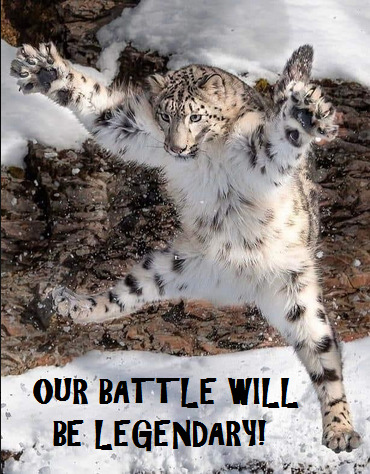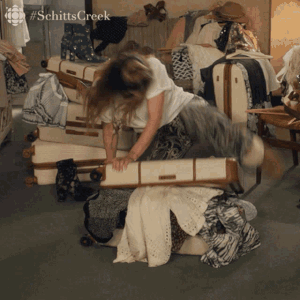Text
"How old were you when you first started writing?"

Actually, it was age 5 or 6.
#writblr#writers on tumblr#writing community#writers of#writers on#writers on ao3#writerscommunity#writer#writers#professional writer#writers life#writing life#writing meme#writing memes#writing humor#que#queue
16 notes
·
View notes
Text
Caught the second before Ron Conigailaro got his ass kicked.


Snow leopard 🐾🐾🐆🐆
Photographer Ron Conigilaro from Detroit, Michigan captured the moment.
6K notes
·
View notes
Text
Holmes and Watson celebrate Passover.

#Sherlock Holmes#Dr. Watson#chag pesach sameach#Passover#Holmes and Watson#pesach#seder#Haggadah#Jewish holidays#tiny food#miniature#miniature food#Dept 56
1 note
·
View note
Text


0 notes
Text
I'm a professional FT writer who plots all my stories. Short stories, novels, fanfics, all of them.
Some people like to wing it. But here's info for those who, like me, prefer not to.
A link to a very rudimentary guideline.
But I suggest, very strongly, that you get yourself to a library and check out books about how to write a novel.
If your library doesn't have many, or any, you can ask the librarian for an Inter Library Loan (ILL). You can borrow a book from anywhere in the country, sometimes from other countries, for free.
Some examples:
Getting into Character by Brandlilyn Collins
The Writer’s Journey by Christopher Vogler
Story Structure Architect by Victoria Lynn Schmidt
20 Master Plots and How to Build Them by Ronald B. Tobias
90 Days to Your Novel by Sarah Domet
From First Draft to Finished Novel by Karen S. Wiesner
Make a Scene by Jordan E. Rosenfeld
Writing the Breakout Novel by Donald Maass
How to Write and Sell a Christian Novel by Gilbert Morris
The Fire in Fiction by Donald Maass
Self-editing for Fiction Writers by Renni Browne and Dave King
I highly recommend The Art of Dramatic Writing by Lajos Egri. This is about writing plays, but it also is perfect for writing prose.
If you're writing in a particular genre -- fantasy, sci fi, mysteries, romance -- you can find books about writing those.
If you don't have a local library, you can buy used books on ebay or on Abebooks. Just buy ones in "acceptable" condition, which are the cheapest. You don't need them to look new, only to be readable copies. You can always buy good copies later if you want to. Also check out any used bookstores in your area.
Professional novelist Alexa Donne has a good video on this. Check out her other videos as well.
youtube
Good writing!
"How do I plot a book" You don't. You start writing. You make notes about ideas you have while writing. When you're finished, you bring everything together like a puzzle. You fix potholes, you delete dead scenes, you bring in funky dialogue. You let someone else read it and put some patches on it. Tada! There's your book.
#writblr#writers on tumblr#writing community#writers of tumblr#plotting#story structure#writing#writers#writing tips#writing advice#writing tools#writing reference#writing research#queue
2K notes
·
View notes
Text
Earth Day.
I was 10 and a memeber of my school's Ecology Club on the first Earth Day. My poster design won a contest. Somewhere I still have the ribbon.
When I was 10 most of America's cities had air pollution. Water pollution was everywhere. Bald eagles, wolves, bison, and many, many animals and birds were on the brink of extinction. Litter was everywhere.
Because people acted, water and air pollution lessened and even disappeared. So did litter. Wildlife was saved.
I wish we'd kept up with this. If we had, America would no longer be dependent on fossil fuel, and everyone would have environmentally and ecologically healthy homes and buildings.
Now when I take walks I see litter all over the place. I see teenagers from the local high school toss their trash wherever they please.
We can go back to the action and idealism of Earth Day, if people have the will to do it, and the willingness to sacrifice.
youtube
.
youtube
.
youtube
I had this Ecology flag patch on my jeans.

4 notes
·
View notes
Text
And so begins my writing week.

When I sit down to write.

#writblr#writers on tumblr#writing community#writers of tumblr#writing#WIP#writing process#writers life#writing life#writing meme#writing memes#and remember kids I'm a professional FT writer and I'm still this way#queue
13 notes
·
View notes
Text
Filling my queue for hiatus.

.
It's all queue from here. It'll run out when it runs out.
#writblr#hiatus#on hiatus#gone writing#novel writing#indefinite hiatus#not available for reblogs replies pretty much anything#writers on tumblr#writing community#writers of tumblr#writerscommunity#writer#writers#writers life#writing stuff#writing meme#writing memes#queue
2 notes
·
View notes
Text
Just . . . the lyrics for Encanto's Waiting for a Miracle.
Lin-Manuel Miranda's word choices. His rhyming.
He perfectly captures a 15-year-old's longing to be equal to her exceptional relatives, to be more than she is. Better than a hell of a lot of middle-grade novels I've read over the past two years.
Don't be upset or mad at all
Don't feel regret or sad at all
Hey, I'm still a part of the family Madrigal
And I'm fine, I am totally fine
I will stand on the side as you shine
I'm not fine, I'm not fine
I can't move the mountains
I can't make the flowers bloom
I can't take another night up in my room
Waiting on a miracle
I can't heal what's broken
Can't control the morning rain or a hurricane
Can't keep down the unspoken invisible pain
Always waiting on a miracle, a miracle
Always walking alone
Always wanting for more
Like I'm still at that door longing to shine
Like all of you shine
All I need is a change
All I need is a chance
All I know is I can't stay on the side
Open your eyes, open your eyes, open your eyes
I would move the mountains
Make new trees and flowers grow
Someone please just let me know, where do I go?
I am waiting on a miracle, a miracle
I would heal what's broken
Show this family something new
Who I am inside, so what can I do?
I'm sick of waiting on a miracle, so here I go
I am ready, come on, I'm ready
I've been patient, and steadfast, and steady
Bless me now as you blessed us all those years ago
When you gave us a miracle
Am I too late for a miracle?
The animation is perfect as well. How Mirabel moves, her expressions. The direction enhances the lyrics. Her going through the door to her grandmother. The telling green firework framing her head as she declares that she's ready for a transformation (green is Bruno's color).
When I get stuck trying to figure out who my characters are I think of them as Disney musical animation characters. I imagine their "I Want" songs, for the protagonist as well as the antagonist. I don't necessarily write lyrics for them (I'm no poet), but I visualize their answers when I ask. "What do you want?"
#writblr#writers on tumblr#writing community#writers of tumblr#lyrics#poetry#character development#introducing characters#writing characters#writing#creative writing#Encanto#Lin-Manuel Miranda#disney#disney animation#walt disney animation studios#animation#musicals#animated musical#queue
5 notes
·
View notes
Text
Shakespeare Saturday: As You Like It.
Yes, I'm in love with Tim McMullan's happily melancholy Jacques, the best I've ever seen.
youtube
youtube

#Shakespeare#As You Like It#Tim McMullan#Jacques#Seven Ages of Man#plays#theatre#theater#Jack Laskey#Shakespeare's Globe#Globe Theatre#William Shakespeare
0 notes
Text
When I'm feeling stuck in my writing, I watch well-told animation. Because it's visual and not words, it helps dislodge me so I can think purely about characters and storytelling.
I'm not a fan of The Princess and the Frog, except for a few of its songs.
This is a perfect example of introducing the villain and his world, revealing the personalities and hidden desires of the prince and Lawrence, and the powers supporting the villain.
As animation should, it visually enhances the words. The Shadows show us Facilier's dark intentions. We see Lawrence's reaction to the card of his deep desire, and understand how he recognizes and readily accepts his deal with the villain in order to achieve his ambition.
This scene foreshadows Facilier's own fate. Here, at his moment of triumph, he slides forward on his knees. But when he breaks his bargain, he is dragged backward to his doom.
#writblr#writers on tumblr#writing#writer#writers#characters#character motivation#storytelling#setting#The Princess and the Frog#Dr. Facilier#writing community#Disney#walt disney animation studios#animation
4 notes
·
View notes
Text
Shakespeare Saturday: Othello.
In Othello Shakespeare doesn't say what Iago looks like. Directors have always assumed that, because of his hatred of Othello, he was white.
In the Royal Shakespeare company's 2015 production they cast Iago as black. Because Iago's hatred is not racism; it's from a feeling of betrayal, of his ambition thwarted in favor of, he believes, a less deserving man.
Lucian Msamati's is the best performance of Iago I've seen.
An interesting take on Roderigo. He's played as a bit thick. The words "thick lips" create a new response because Iago is black.
youtube
.
youtube
I do still love Bob Hoskin's Iago.
youtube
#Shakespeare#Othello#william shakespeare#plays#theatre#theater#Iago#Lucian Msamati#Bob Hoskins#Hugh Quarshie#Royal Shakespeare Company#2015
4 notes
·
View notes
Text
Shakespeare Saturday: Twelfth Night.
Taking a break from writing, I'm rewatching some of my favorite Shakespeare adaptations.
Twelfth Night, National Theatre, 2017. One of the few times I think changing the character's sex has worked well: Malvolio is Malvolia and Feste is female. Tim McMullan is brilliant as Sir Toby Belch.
Tamara Lawrance as Viola disguised as Cesario.
youtube
#shakespeare#william shakespeare#twelfth night#theatre#theater#plays#Tim McMullan#Tamara Lawrance#Tamsin Greig#Daniel Rigby#Niky Wardley#Doon Mackichan#Sir Toby Belch#Malvolio#Malvolia#Feste#Sir Andrew Aguecheek#Maria#National Theatre#Youtube
0 notes
Text
This is adorable, but speaking as a former maid --
A white shag carpet??
Are you fucking kidding me?
And she owns a dog??
Do you have any fucking idea how hard it is to keep that sucker clean??
No, of course you don't. Because you don't clean it.
Tell me you hire other people to clean your house without telling me you hire other people to clean your house.
How to catch a puppy
#dog#doggy#puppy#cute pet#white fucking shag carpet#jeezus crispy christ#woman with white carpet and white pillows and white-painted fireplace I know exactly what you're like#former maid
6K notes
·
View notes
Text
The Courage to Follow the Evidence on Transgender Care.
(WOW, the New York Times -- which a couple years ago had an ad about a qu**r girl who wished for a world in which J.K. Rowling wasn't the author of Harry Potter -- has published yet another opinion piece about trans, this one about the Cass Review. Personally, I think he's too lenient, but at least he's bringing attention to the review to Americans. )
(For those who can't read the NYT page, here's the text.)

Opinion, David Brooks, April 18, 2024.
Hilary Cass is the kind of hero the world needs today. She has entered one of the most toxic debates in our culture: how the medical community should respond to the growing numbers of young people who seek gender transition through medical treatments, including puberty blockers and hormone therapies. This month, after more than three years of research, Cass, a pediatrician, produced a report, commissioned by the National Health Service in England, that is remarkable for its empathy for people on all sides of this issue, for its humility in the face of complex social trends we don’t understand and for its intellectual integrity as we try to figure out which treatments actually work to serve those patients who are in distress. With incredible courage, she shows that careful scholarship can cut through debates that have been marked by vituperation and intimidation and possibly reset them on more rational grounds.
Cass, a past president of Britain’s Royal College of Pediatrics and Child Health, is clear about the mission of her report: “This review is not about defining what it means to be trans, nor is it about undermining the validity of trans identities, challenging the right of people to express themselves or rolling back on people’s rights to health care. It is about what the health care approach should be, and how best to help the growing number of children and young people who are looking for support from the N.H.S. in relation to their gender identity.”
This issue begins with a mystery. For reasons that are not clear, the number of adolescents who have sought to medically change their sex has been skyrocketing in recent years, though the overall number remains very small. For reasons that are also not clear, adolescents who were assigned female at birth are driving this trend, whereas before the late 2000s, it was mostly adolescents who were assigned male at birth who sought these treatments.
Doctors and researchers have proposed various theories to try to explain these trends. One is that greater social acceptance of trans people has enabled people to seek these therapies. Another is that teenagers are being influenced by the popularity of searching and experimenting around identity. A third is that the rise of teen mental health issues may be contributing to gender dysphoria. In her report, Cass is skeptical of broad generalizations in the absence of clear evidence; these are individual children and adolescents who take their own routes to who they are.
Some activists and medical practitioners on the left have come to see the surge in requests for medical transitioning as a piece of the new civil rights issue of our time — offering recognition to people of all gender identities. Transition through medical interventions was embraced by providers in the United States and Europe after a pair of small Dutch studies showed that such treatment improved patients’ well-being. But a 2022 Reuters investigation found that some American clinics were quite aggressive with treatment: None of the 18 U.S. clinics that Reuters looked at performed long assessments on their patients, and some prescribed puberty blockers on the first visit.
Sign up for the Opinion Today newsletter Get expert analysis of the news and a guide to the big ideas shaping the world every weekday morning. Get it sent to your inbox.
Unfortunately, some researchers who questioned the Dutch approach were viciously attacked. This year, Sallie Baxendale, a professor of clinical neuropsychology at the University College London, published a review of studies looking at the impact of puberty blockers on brain development and concluded that “critical questions” about the therapy remain unanswered. She was immediately attacked. She recently told The Guardian, “I’ve been accused of being an anti-trans activist, and that now comes up on Google and is never going to go away.”
As Cass writes in her report, “The toxicity of the debate is exceptional.” She continues, “There are few other areas of health care where professionals are so afraid to openly discuss their views, where people are vilified on social media and where name-calling echoes the worst bullying behavior.”
Cass focused on Britain, but her description of the intellectual and political climate is just as applicable to the U.S., where brutality on the left has been matched by brutality on the right, with crude legislation that doesn’t acknowledge the well-being of the young people in question. In 24 states Republicans have passed laws banning these therapies, sometimes threatening doctors with prison time if they prescribe the treatment they think is best for their patients.
The battle lines on this issue are an extreme case, but they are not unfamiliar. On issue after issue, zealous minorities bully and intimidate the reasonable majority. Often, those who see nuance decide it’s best to just keep their heads down. The rage-filled minority rules.
Cass showed enormous courage in walking into this maelstrom. She did it in the face of practitioners who refused to cooperate and thus denied her information that could have helped inform her report. As an editorial in The BMJ puts it, “Despite encouragement from N.H.S. England,” the “necessary cooperation” was not forthcoming. “Professionals withholding data from a national inquiry seems hard to imagine, but it is what happened.”
Cass’s report does not contain even a hint of rancor, just a generous open-mindedness and empathy for all involved. Time and again in her report, she returns to the young people and the parents directly involved, on all sides of the issue. She clearly spent a lot of time meeting with them. She writes, “One of the great pleasures of the review has been getting to meet and talk to so many interesting people.”
The report’s greatest strength is its epistemic humility. Cass is continually asking, “What do we really know?” She is carefully examining the various studies — which are high quality, which are not. She is down in the academic weeds.
She notes that the quality of the research in this field is poor. The current treatments are “built on shaky foundations,” she writes in The BMJ. Practitioners have raced ahead with therapies when we don’t know what the effects will be. As Cass tells The BMJ, “I can’t think of another area of pediatric care where we give young people a potentially irreversible treatment and have no idea what happens to them in adulthood.”
She writes in her report, “The option to provide masculinizing/feminizing hormones from age 16 is available, but the review would recommend extreme caution.” She does not issue a blanket, one-size-fits-all recommendation, but her core conclusion is this: “For most young people, a medical pathway will not be the best way to manage their gender-related distress.” She realizes that this conclusion will not please many of the young people she has come to know, but this is where the evidence has taken her.
You can agree or disagree with this or that part of the report, and maybe the evidence will look different in 10 years, but I ask you to examine the integrity with which Cass did her work in such a treacherous environment.
In 1877 a British philosopher and mathematician named William Kingdon Clifford published an essay called “The Ethics of Belief.” In it he argued that if a shipowner ignored evidence that his craft had problems and sent the ship to sea having convinced himself it was safe, then of course we would blame him if the ship went down and all aboard were lost. To have a belief is to bear responsibility, and one thus has a moral responsibility to dig arduously into the evidence, avoid ideological thinking and take into account self-serving biases. “It is wrong always, everywhere, and for anyone, to believe anything upon insufficient evidence,” Clifford wrote. A belief, he continued, is a public possession. If too many people believe things without evidence, “the danger to society is not merely that it should believe wrong things, though that is great enough; but that it should become credulous, and lose the habit of testing things and inquiring into them; for then it must sink back into savagery.”
Since the Trump years, this habit of not consulting the evidence has become the underlying crisis in so many realms. People segregate into intellectually cohesive teams, which are always dumber than intellectually diverse teams. Issues are settled by intimidation, not evidence. Our natural human tendency is to be too confident in our knowledge, too quick to ignore contrary evidence. But these days it has become acceptable to luxuriate in those epistemic shortcomings, not to struggle against them. See, for example, the modern Republican Party.
Recently it’s been encouraging to see cases in which the evidence has won out. Many universities have acknowledged that the SAT is a better predictor of college success than high school grades and have reinstated it. Some corporations have come to understand that while diversity, equity and inclusion are essential goals, the current programs often empirically fail to serve those goals and need to be reformed. I’m hoping that Hilary Cass is modeling a kind of behavior that will be replicated across academia, in the other professions and across the body politic more generally and thus save us from spiraling into an epistemological doom loop.
#cass review#the cass review#cass report#the cass report#transgender#trans#trans insanity#the tide is turning#gender critical#gender ideology#gender identity#gender cult#gender madness
44 notes
·
View notes
Text

Do you ever miss a character from a show but not like in the way that you want to rewatch the whole show because theres so much stuff going on and thats not what youre looking for but you miss your boy
#Gabriel#Hawk Moth#miraculous ladybug#I miss my boy#mlb#miraculous#miraculous tales of ladybug and chat noir#hot villain#queue
17K notes
·
View notes
Photo

OK, @queen-administrator and everybody else, let me explain, since I was alive then.
1967 was a time of social upheaval, of breaks with tradition and shattering social conventions. Because of the introduction of the Pill in 1960, and women now being able to choose whether or not to get pregnant, there was the Sexual Revolution. Girls and women were struggling to redefine what being female meant.
In 1967 women wore heels. All women. Everywhere. Sandals were for the beach. Birkenstocks had only just begun being sold in the U.S. the year before, and only hippie college students wore them. Sneakers as we know them today did not exist (didn't until the 80s). Converse sneakers were for sports or young children (I didn't get my first pair until 1970).
1967 was a year before the Women's Liberation Movement took off. Women were expected to wear heels of at least 2 inches. You could wear loafers, but they had to have heels higher than Men's loafers. You wore heels at work -- if you had a job -- even in factories and restaurants. Artsy college girls and Beats (beatniks) sometimes wore ballet flats, but those were frowned upon as expressions of being "liberated."
The girls in this illustration are wearing mini skirts, which were a new fashion trend and very shocking at the time. Mini skirts were created in England and didn't come to the U.S. until 1965.
The reason the nun is wearing heels is because this was after Vatican 2.
Vatican 2 was in 1962. in a nutshell, it changed some of the traditions of the Catholic Church. This included nuns allowed to choose whether to wear traditional habits or more modern designs, or a mixture.
Some nuns decided to test incorporating modern women's clothes with their habits. That's what's happening in this illustration. You can't imagine how everything in this picture was amazing and shocking in '67, especially for a mainstream, traditional publication like Readers Digest.

Nun in red heels from Readers Digest magazine, ca 1967.
#women#women's history#fashion history#sexual revolution#60s#1967#women's liberation#women's lib#Vatican II#birkenstocks#american history#cultural revolution
52K notes
·
View notes